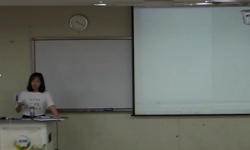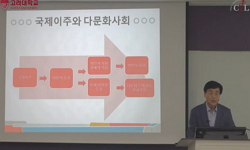Multiliteracies refer to an expanded concept of literacy that encompasses the ability to understand and communicate information in multilingual, multicultural, and multimodal contexts, going beyond traditional notions of reading and writing. In today...
http://chineseinput.net/에서 pinyin(병음)방식으로 중국어를 변환할 수 있습니다.
변환된 중국어를 복사하여 사용하시면 됩니다.
- 中文 을 입력하시려면 zhongwen을 입력하시고 space를누르시면됩니다.
- 北京 을 입력하시려면 beijing을 입력하시고 space를 누르시면 됩니다.
https://www.riss.kr/link?id=T17171540
- 저자
-
발행사항
서울 : 한국외국어대학교 KFL대학원, 2025
-
학위논문사항
학위논문(석사) -- 한국외국어대학교 KFL대학원 , 외국어로서의한국어교육학과 , 2025. 2
-
발행연도
2025
-
작성언어
한국어
- 주제어
-
DDC
495.107K 판사항(22)
-
발행국(도시)
서울
-
기타서명
A study on the teaching-learning method of Korea's value culture 'Collectivism' using multiliteracy
-
형태사항
[iv], 146 p. : 삽도 ; 26 cm
-
일반주기명
한국외국어대학교 논문은 저작권에 의해 보호받습니다.
지도교수: 한혜민
참고문헌: p. 137-143 -
UCI식별코드
I804:11059-200000853619
- 소장기관
-
0
상세조회 -
0
다운로드
부가정보
다국어 초록 (Multilingual Abstract)
This study focuses on teaching “Korean collectivism,” a concept deeply intertwined with the experiences of learners seeking meaningful interactions with Korean society. Through their encounters with Korean culture, learners may experience the dichotomy of inclusion within or exclusion from the Korean ‘우리’(we). Those who are part of this collective may perceive ‘정’(an emotional bond), while those outside may face boundaries, biases, and discrimination. A solid understanding of Korean collectivism is foundational for comprehending Korea’s family-oriented values and relational dynamics. However, as collectivism represents an abstract and intangible cultural concept, the use of diverse, level-appropriate media is an effective means of facilitating foreign learners’ understanding of Korean culture.
Teaching Korean collectivism through multiliteracies not only deepens learners’ comprehension of the topic but also equips them to critically evaluate cultural information, minimizing the risks of unfiltered exposure to misleading content.
This research is organized into the following chapters. Chapter 1 examines prior studies to identify trends in multiliteracies and cultural value education within Korean language teaching. Chapter 2 explores the theoretical foundations and characteristics of multiliteracies, interculturalism, and Korean collectivism. Chapter 3 presents educational objectives, content, and systematically designed models for teaching Korean collectivism using multiliteracies, alongside specific teaching and learning materials. Chapter 4 outlines a step-by-step framework and practical teaching strategies for implementing a multiliteracies-based cultural education model.
The significance of this research lies in several key aspects. First, it provides a concrete instructional framework for teaching the intangible cultural values of Korea using multiliteracies, tailored to the needs of learners adept at constructing and utilizing complex meanings through various modalities. Second, it shifts the focus from teacher-centered instruction to learner-driven participation, enabling learners to explore the connections between their own lives and Korean cultural values while internalizing these insights independently. Third, by analyzing Korean cultural values alongside their own, learners are encouraged to adopt an intercultural perspective, fostering mutual understanding and critical reflection. Lastly, this study emphasizes the importance of cultural coexistence, demonstrating how cultural exchange can pave the way for a harmonious integration of diverse cultures and presenting activities that support such coexistence.
As language learning inherently places learners at the intersection of their own culture and the target culture, this dual perspective allows them to serve as bridges between the two. By cultivating a nuanced understanding of both self and other, learners develop the ability to appreciate cultural diversity without hierarchizing or devaluing any culture. Believing that the ultimate goal of cultural education is coexistence, this research aspires to contribute to the development of globally aware learners equipped with digital-era competencies. Through Korean cultural education, it seeks to encourage learners to grow into global citizens who actively contemplate and work toward cultural harmony.
Multiliteracies refer to an expanded concept of literacy that encompasses the ability to understand and communicate information in multilingual, multicultural, and multimodal contexts, going beyond traditional notions of reading and writing. In today’s world, Korean language learners engage with diverse digital media, as well as traditional texts, to comprehend and interact with their surroundings. To address these learner characteristics, Korean language education must incorporate a variety of media that encourage active learner participation and allow students to take initiative in their learning process, transforming them into independent and engaged participants rather than passive recipients.
This study focuses on teaching “Korean collectivism,” a concept deeply intertwined with the experiences of learners seeking meaningful interactions with Korean society. Through their encounters with Korean culture, learners may experience the dichotomy of inclusion within or exclusion from the Korean ‘우리’(we). Those who are part of this collective may perceive ‘정’(an emotional bond), while those outside may face boundaries, biases, and discrimination. A solid understanding of Korean collectivism is foundational for comprehending Korea’s family-oriented values and relational dynamics. However, as collectivism represents an abstract and intangible cultural concept, the use of diverse, level-appropriate media is an effective means of facilitating foreign learners’ understanding of Korean culture.
Teaching Korean collectivism through multiliteracies not only deepens learners’ comprehension of the topic but also equips them to critically evaluate cultural information, minimizing the risks of unfiltered exposure to misleading content.
This research is organized into the following chapters. Chapter 1 examines prior studies to identify trends in multiliteracies and cultural value education within Korean language teaching. Chapter 2 explores the theoretical foundations and characteristics of multiliteracies, interculturalism, and Korean collectivism. Chapter 3 presents educational objectives, content, and systematically designed models for teaching Korean collectivism using multiliteracies, alongside specific teaching and learning materials. Chapter 4 outlines a step-by-step framework and practical teaching strategies for implementing a multiliteracies-based cultural education model.
The significance of this research lies in several key aspects. First, it provides a concrete instructional framework for teaching the intangible cultural values of Korea using multiliteracies, tailored to the needs of learners adept at constructing and utilizing complex meanings through various modalities. Second, it shifts the focus from teacher-centered instruction to learner-driven participation, enabling learners to explore the connections between their own lives and Korean cultural values while internalizing these insights independently. Third, by analyzing Korean cultural values alongside their own, learners are encouraged to adopt an intercultural perspective, fostering mutual understanding and critical reflection. Lastly, this study emphasizes the importance of cultural coexistence, demonstrating how cultural exchange can pave the way for a harmonious integration of diverse cultures and presenting activities that support such coexistence.
As language learning inherently places learners at the intersection of their own culture and the target culture, this dual perspective allows them to serve as bridges between the two. By cultivating a nuanced understanding of both self and other, learners develop the ability to appreciate cultural diversity without hierarchizing or devaluing any culture. Believing that the ultimate goal of cultural education is coexistence, this research aspires to contribute to the development of globally aware learners equipped with digital-era competencies. Through Korean cultural education, it seeks to encourage learners to grow into global citizens who actively contemplate and work toward cultural harmony.
목차 (Table of Contents)
- 1. 서론 1
- 1.1. 연구 목적 및 필요성 1
- 1.2. 선행 연구 4
- 1.2.1. 한국어교육에서의 멀티리터러시 교육에 관한 연구 4
- 1.2.2. 한국어교육에서의 멀티리터러시 기반 교수-학습 방안 연구 8
- 1. 서론 1
- 1.1. 연구 목적 및 필요성 1
- 1.2. 선행 연구 4
- 1.2.1. 한국어교육에서의 멀티리터러시 교육에 관한 연구 4
- 1.2.2. 한국어교육에서의 멀티리터러시 기반 교수-학습 방안 연구 8
- 1.2.3. 매체 활용 기반 한국 가치문화 교육에 관한 연구 17
- 2. 이론적 배경 26
- 2.1. 멀티리터러시(Multiliteracy) 26
- 2.1.1. 멀티리터러시의 개념 26
- 2.1.2. 멀티리터러시의 교육 원리 35
- 2.1.3. 한국어교육에서 멀티리터러시 교육의 필요성 42
- 2.2. 상호문화주의(Interculturalism) 45
- 2.2.1. 상호문화주의와 상호문화 능력의 개념 46
- 2.2.2. 한국어교육에서 상호문화교육의 필요성 51
- 2.3. 한국의 집단주의 54
- 2.3.1. 집단주의의 개념 54
- 2.3.2. 한국 집단주의의 특징 58
- 3. 멀티리터러시 활용 한국 가치문화 교수-학습 방안 설계 67
- 3.1. 학습 목표 및 학습자 선정 67
- 3.1.1. 학습 목표 67
- 3.1.2. 학습자 선정 72
- 3.2. 교수-학습 내용 77
- 3.2.1. 집단주의와 개인주의 78
- 3.2.2. 한국의 집단주의 81
- 3.2.3. 현대 한국의 집단주의 변화 양상 85
- 3.3. 교수-학습 모형 87
- 3.4. 교수-학습 매체 및 자료 설계 100
- 4. 멀티리터러시 활용 한국 가치문화 교수-학습의 실제 108
- 4.1. 단계별 수업 과정 안 108
- 4.2. 차시별 수업 과정 안 125
- 5. 결론 및 제언 134
- 참고 문헌 137
- ABSTRACT 144









